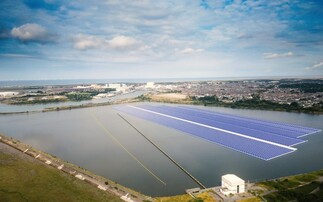Solar Trade Association's Leonie Greene welcomes the government's new strategy, but asks why Ministers have to detract from the launch by bashing solar farms?
There is much to celebrate in the UK's newly published solar strategy. A target of one million solar homes in the UK in 2015 is truly ambitious and world-class. It's a target we have been championing at the Solar Trade Association and which, to be met, would require a 50 per cent increase in domestic deployment levels compared to the past three years - beautifully bold but certainly achievable.
Equally exciting is the commitment to open up "every inch" of the government estate to solar deployment. That's leading by example. The strategy's assessment of the UK's strengths in solar R&D, product design and manufacturing skills is a canny move when the global solar market is estimated at $134bn by 2020. Let's hope this is taken forward via a meaningful industrial strategy at BIS. And of course, strategically it is vital for the industry that the market across mid and large scale roofs takes off.
Following reports by McKinsey, Deutsche Bank, The Royal Society, IEA and countless others, the role of solar power in mitigating climate change and transforming ownership in power generation should now be clear. The Intergovernmental Panel on Climate Change (IPCC) will shortly set out solar's exceptional technical potential to meet all the world's energy needs cleanly. Solar is at the heart of solving the humanitarian and environmental crisis we face, but the IPCC will note continued cost reduction is key to meeting this challenge. Good news then that the European Commissions's quiet reduction in the Minimum Import Price for Chinese solar this month confirms that panel cost reductions continue globally, regardless of what happens in China.
The UK solar strategy anticipates that solar will reach parity with gas in the UK around 2025. I'd say that's pessimistic for solar and optimistic for shale gas. The United States government's SunShot initiative aims specifically to bring solar down to the price of fossil fuels by 2020 and is supporting 140 different projects to achieve that - how's that for a solar strategy? Interestingly US solar giant First Solar anticipates hitting parity with gas three years earlier i.e. in 2017.
Given on site solar competes with retail electricity prices, we expect solar to reach parity for onsite investors before the end of the decade, if the right policy framework is in place. We know that large roof applications in several EU countries are on the brink of parity, so it's vital that the UK large roof market catches up. But modules are only a portion of installed costs. The majority of costs, for domestic and even large solar farms, are balance of system costs, which comprise costs such as skilled labour (solar is labour intensive), grid connections, mounting systems, finance, land or roof rental, planning processes, operation and maintenance - and more besides. Thankfully, these issues are addressed by the new UK strategy.
But to deliver lowest cost solar in the UK, it is vital that the industry has a stable policy framework in order to make those investments at an early stage in a skilled workforce, supply chains and installation methods to secure minimum balance of system costs. The practical delivery framework also needs to be as smooth as possible to minimize risk and cost, whether that's grid connections, efficient registration processes, or a plethora of other regulatory hurdles.
So it was disappointing that a negative spin on solar farms was put on the launch of what was otherwise an excellent and positive first UK solar strategy. The strategy itself is actually very fair and reasonable on solar farms, though you wouldn't know that from reading the headlines. The big problem with Minister Greg Barker's public criticism of solar farms is that is what his department's policy framework delivers.
Please don't blame the industry. And please don't apologise - solar farms are the most popular local utility energy development according to our YouGov polling. They are also set to be the cheapest low carbon power source around 2018 and DECC says value-for-money matters. Crucially, DECC does not yet have an effective framework for mid/large solar roofs that will allow the industry to expand significantly, which is what the Minister is clear he wants.
For the best part of a year, the STA has been pushing for a careful rebalancing of the UK solar market to achieve equally dynamic deployment amongst the domestic, utility (solar farm) and mid/large roof sectors. That does not mean damaging investor confidence in utility solar, and particularly not when the industry has nowhere to go. Rebalancing the UK market means putting in place a robust feed-in tariff policy framework, and appropriate Levy Control Framework funds, to support the expansion of mid to large solar roofs for commercial, industrial, public-sector and community investors. Then, and only then, it means encouraging a rebalancing of the market.
But it also means retaining good quality solar farms and recognising the important public goods they are delivering. Solar farms developments are outside the "Big Six" and dominated by pioneering smaller businesses. They are delivering independent generation that is diversifying the UKs consolidated electricity market, including by boosting small green electricity suppliers.
Responsible solar farm developers want to operate within a strong planning framework that sifts out poor schemes. Strategically the solar farm industry is going for quality, by delivering multiple benefits for the countryside - that is something we'd like DECC to support. So important questions remain about how the need to safeguard quality will fare under competitive auctioning, where cost is king. The STA will be launching detailed guidance on biodiversity for solar farms produced with the NSC, The National Trust, RSPB, Plantlife, Buglife, The Bumblee Conservation Trust and others soon - will policy support the potential to turn solar farms into biodiversity hot spots? We're working on the Shared Ownership Taskforce on opportunities for local ownership - how will that fit with auctioning?
Currently we are taking on trust that DECC will bring forward essential changes to the feed-in tariff scheme to ensure the rooftop vision set out in last weeks' Solar Strategy can be fulfilled. That means substantial increases in the 50kW -5MW feed-in tariff capacity trigger thresholds. The whole industry now awaits these changes. The Renewables Obligation has some limited potential here but it is due to be abolished in 2017. It is also often too complex for community, public sector, and commercial sector investors.
So it's great news that the government is getting strategic about this extraordinary technology in the UK. Full marks to DECC for that. But let's hope politicians of all parties remember, when it comes to stealing a march in the global race and delivering lowest cost solar, stability and investor confidence is key.
Leonie Greene is head of external relations for the Solar Trade Association








